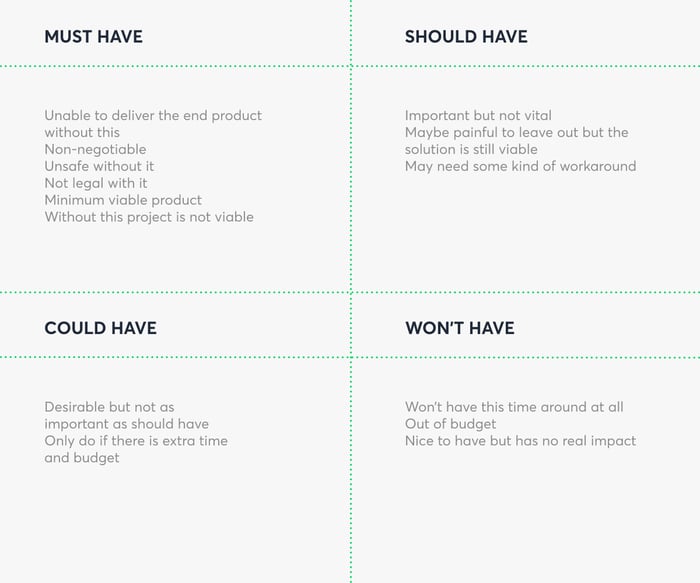How to Track Priorities in a Project with the MoSCoW Matrix Canvas

This article will demonstrate how this product management tool can help your team to identify the key resources they need, the tasks they need to focus on, and the key priority at any given time.
It will also explain how performing a MoSCoW analysis is important, and it will outline why the MoSCoW principle is essential in delivering a viable solution of how to approach complex projects. Along with, showing you how to present a simple process that all your team members can benefit from during the product management process.
What is the MoSCoW Matrix Canvas?
The MoSCoW Matrix Canvas (also referred to as The MoSCoW prioritization technique, the deliverables matrix, or the MoSCoW analysis model) is a form of prioritization technique. It helps:
- Product managers
- Project managers
- Marketing managers
- Product developers, business analysts
- Other important team members involved in the creation and planning of a product.
It does this by effectively establishing the top priority requirements within any given product. Using the MoSCoW template ensures that teams can effectively prioritise their project tasks and their related requirements.
Being able to prioritise tasks effectively is of the utmost importance when a product development team is aiming to deliver a task, a created product, or other features considered important by the various stakeholders involved in the company within a specific timeframe.
The MoSCoW method therefore enables teams to plan how their resources are used, and how their time is spent achieving their tasks for their projects.
The MoSCoW method template is split into four categories:
- Must haves
- Should haves
- Could haves (or nice to haves)
- Will not/won’t haves
It is recommended that your team manage to settle any disputes that they have in regards to prioritization before they begin constructing a MoSCoW matrix canvas.
If possible, team members should create a process that is intended specifically for the purpose of resolving conflicts.
Including such a process and managing to resolve conflicts will make it far easier for team members to agree on the initiatives, and will help them to better understand what needs to be focused on and compared.
When to use the MoSCoW Method
It is best to use the MoSCoW method whenever you aim to include all of the relevant stakeholders from your company in the process. This enables you to capture a broad and varied understanding of everything that needs to be considered when working on a project or building a product.
Product managers can use this method to review and rank the importance of tasks, thoughts, opinions, and initiatives. The more input, the better the decisions made.
This method can be used in all sorts of situations, such as product development, and the general carrying out of business projects.
Ideally, it will always be used in the initial stages of a project, so as to make the best decisions about how to proceed moving forward, rather than deciding this later on.
How to create the MoSCoW Canvas - The four categories of initiatives
You may have noticed that MoSCoW is actually an acronym. The first letter stands for ‘Must Haves’, the second letter stands for ‘Should Haves’, and so on. The four prioritization categories are as follows:
Must Haves
Must have initiatives are as the name suggests, a ‘must’. These refer to requirements for your project that are not up for negotiation in terms of their inclusion.
For instance, if you are building a chat app for a website, you must include a function that records responses and sends them to an appropriate email address or app, otherwise, important information will be lost.
This section will also include tasks that need to be completed in order for the project to be carried out successfully.
Team members should consider the following questions when deciding whether or not tasks should be included within a project:
- Is it possible for the product to function without this task being completed?
- Is there an easier method of completing this task?
- What are the potential consequences of not including these initiatives?
Should Haves
Should have initiatives are highly important but not ‘must haves’ because the project/product can still function without them.
The problem with not including them is that the project or product may end up missing things that could be particularly beneficial or which may have significantly improved everything.
Should haves may be something for consideration in the future (e.g. if a video game requires fixes to bugs, additional content added or removed, etc, this could be achieved later on).
Could Haves
Could haves can also be described as ‘nice-to-haves’. They are not essential, but their lack of inclusion won’t cause much of a problem in the long run.
The difference between should haves and could haves is that should haves still need to be in immediate consideration to be included in the product or project at the earliest possible moment, whereas could haves do not have such a profound impact.
For example, offering a product in a range of different colors. If you only offer one color, the product will still sell and the project will have been a success (in terms of getting the product to market). But the inclusion of additional colors could help to boost sales by appealing to different aesthetic tastes.
Won’t Haves
Simply put, this section helps you to understand everything that is not a priority at a given time. It may be that many things included here could be considered for future product releases, but ultimately it helps to weed out anything that is not an absolute priority.
Won’t haves could include smaller or cheaper versions of the product (with less features included). This is because your team may decide that it's more important to get the initial product out to market first, and then see how it performs before considering offering alternative versions of the same product.
You should compare could haves, should haves, won’t haves, and must haves in order to fully understand which ones hold the most importance, and which ones can be left for now (either indefinitely, or to be picked up later on).
Once you have made your decisions, you should then focus on allocating a certain amount of resources to each category. From here you should then begin matching the most appropriate categories with the initiatives (goals, tasks etc) that they match with.
This is best achieved through the addition of a ranking/scoring system. Some good examples of scoring models include the kano model, weighted scoring, and opportunity scoring, to name a few.
How can you benefit from using the MoSCoW Canvas?
There are many benefits of using this system. Stakeholder input is perhaps one of the biggest since everyone involved (from all over the organization) can have a hand in the development of a product or process, and therefore, can influence it for the better.
Elsewhere it improves the prioritization of tasks and projects in general since everyone agrees on what should and should not be included.
The MoSCoW method is simple to use, easy to understand, and can be executed in a straightforward manner. This method will save valuable time that can be used elsewhere to help benefit the business in other ways.
What are the disadvantages of the MoSCoW Canvas?
Not objective - A pretty significant downside of using the MoSCow matrix canvas is the fact that it does not include an objective system with which team members can fairly rank the initiatives with each other (to determine their importance).
It’s inherently subjective, and that’s problematic. This is because everyone involved will approach what they deem as important from different viewpoints, and people will disagree on what is important.
One way to combat this might be for everyone to agree on some form of a weighted scoring system that is compared with a pre-approved criterion that everyone agrees upon. That way, at least the system of scoring is fair and everyone agrees with it.
Bias - It is pretty much impossible to prevent people’s own opinions, concerns, and viewpoints from getting in the way of a purely objective response in the decision-making and planning process. Again, agree first on the approach of ranking initiatives, and then try your best to keep bias out of the equation.
Stakeholder Inclusion - If you don’t include everyone in the team that is connected with your product or project in the ranking process, there is a danger that you may fail to cover all your bases in terms of considering the important factors involved.
As we discussed before, having all of the relevant stakeholders involved means that the process will be open to bias, conflicts of interest, and other issues. It’s not an ideal situation, so make sure that you work hard on respecting ideas, viewpoints, and improving communication.
Example of the MoSCoW Canvas
The image below depicts a requirements matrix template (the MoSCow method template or MoSCoW prioritization template). This is a more creative way that you could visualize and map out the requirements of your project.

Source: MoSCoW Matrix
Track priorities easier using the Moscow Matrix Canvas
It is clear that by using the MoSCoW method templates, you can learn how to better classify tasks according to how important or necessary they are within a major pipeline. Instead of the complete rejection of ideas, you can seek to compare and contrast them, meaning that team members can come to a more civil agreement on what is most needed at any given time.
The MoSCoW requirements template is a powerful solution to the issue of prioritization and process planning, and it allows companies to achieve a healthy balance between the many tasks they have to implement and execute, thereby accurately establishing those with the lowest priority, and those with the highest.
By introducing this technique into their daily routine, they can seek to carry out their projects in a timely manner, meaning that they won't miss an important deadline due to an inability to properly plan and distinguish between the priorities within a project. So what’s stopping you from using the MoSCoW matrix canvas today?







